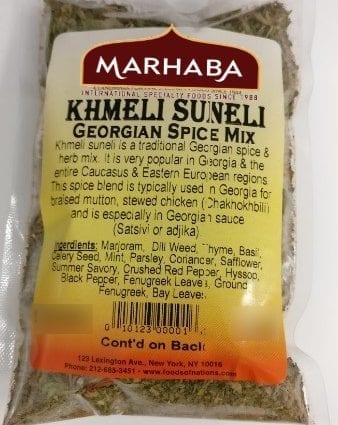And what do I want? .. I want to cook kharcho – the recipe says in black and white: “Put hops-suneli“. Cilantro, tarragon, reikhan – I know, tsitsaku (hot chilli pepper), kondari (savory) – I know, but what is it? It took a good half hour to explain this term. Now I can share the acquired wisdom with you.
I will disappoint: it has nothing to do with hops and intoxicated, but means “dry”. The bag that the seller pulled out was just a set of dried and chopped herbs, seasonings, without which it is impossible to cook kharcho, cook adjika, bungle satsivi, concoct nut sauce bazhe and even … fry the right chicken tobaccowhich is actually “tapaka”. Classically, such a set includes coriander, fenugreek, dill, bay leaf, basil, savory, celery, marjoram and other spices. Naturally, the latter – “other spices” – completely kills any immutable composition of the set, because they usually make it on a whim or as “grandmother taught.” There is Imeretian saffron on hand – why not pour it? What’s wrong with mint? There … Well, they do not like uniformity in Georgia, but they love creativity, because GOST on hops-suneli no and never has been.
Now about the application. Phrases like “the norm of the bookmark suneli 0,2 g” always put me into a stupor … Why exactly so much and how to weigh it, if a teaspoon contains about 7 grams? Undoubtedly hops-suneli It smells good, but its powerful aroma can overpower the other ingredients in the dish. Therefore, you should not abuse the seasoning – in any amount (reasonable) it is appropriate only in kharcho and adjika… But, for example, in satsivi and lobio hops-suneli put only because of universality – purists are outraged and insist on utskho-suneli.
New word – ucho-suneli… I learned about this spice when my Tbilisi friend was preparing lobio and poured a pinch of a pleasant gray-green powder into it. It turns out that the Georgians separated from all their sunelis blue fenugreek, calling it “alien” – “utskho”, most likely because they got acquainted with this typically Indian spice relatively recently. Everything is not easy here. Blue fenugreek is found in the Caucasus as a weed, but is often bred as a spice. But hay fenugreek, also known as Shambhala, is an Indian species. What a packaged utskho-suneli is today is known only to God and botanists. In Georgia, this is probably the first species, in foreign versions – the second (let’s not get boring: they are similar in taste and aroma).
Why the Georgians decided that cilantro, reikhan, tarragon are relatives, and the fenugreek growing under their feet is a stranger, it is not clear. But a stranger is a stranger, and now it is one of the main spices in Georgia, since it gives dishes a nutty flavor, so beloved in this country. Keep in mind that the finished powder is sometimes bitter, it is better to use freshly ground seeds. However, many Georgian chefs do not like troubles, and if ucho-suneli it was not at hand, they pour it into satsivi hops-suneli… Fenugreek comes in decent proportions in this spicy mixture. So the nutty flavor is still guaranteed.










